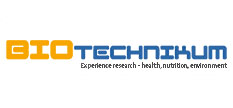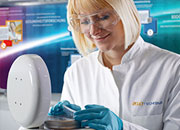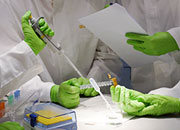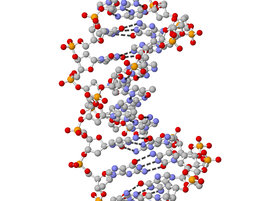Biotechnology – Technical processes
Developments in molecular biology, analytics, information and communication technology and many other fields have opened up a vista of new opportunities for research in biotechnology over the past few years. State-of-the-art detection methods are both highly sensitive and cost-efficient. Today, huge research data volumes can be gained and processed. Only since then has it become possible to decode biological processes with their extreme complexity. The umbrella word ”Omics“ has established itself in the scientific literature, its most common derivatives being genomics, proteomics and metabolomics.
Genomics – genome research
The hereditary information of organisms, the genome, is the building plan for all life processes. In order to investigate life, science therefore attempts to understand the hereditary information and its functions. The more successful we are in genomic research, the better we can modify or employ the biological processes – for example for diagnostic or therapeutic purposes.
Human genome research
One of the most significant and spectacular results of genome research was the complete decoding of human hereditary information as part of the international Human Genome Project. However, knowing the fundamental structure of human hereditary information is only the beginning. The next step is to understand the function and complicated interaction of genes and to identify the genetic causes of various diseases. This way the results of genome research can lead to improved diagnostic systems and new therapies – diseases can be detected earlier and treated better.
Genome research on microorganisms
Bacteria (prokaryotes) are present virtually across the globe. Some strains have adapted to extreme conditions (extremophiles). They survive in hot springs at temperatures over 100 °C, under high pressure in the depths of the oceans, or under metres of ice layers. Although bacteria – unlike higher cells – do not possess a cell nucleus and are rather simple in structure, they have amazing metabolic capabilities: there is hardly a chemical substance they cannot utilise. What is it that gives them these abilities? Enzymes, which enable many metabolic reactions as biocatalysts in the first place, and genes which form the building plan for such enzymes.
Decoding the structure and function of bacterial hereditary information is the objective of microbial genome research. The results are especially interesting for the technical application of enzymes. They can be employed in a number of ways in industrial processes depending on their individual properties: at low or high pressures, in acidic and alkaline milieu alike. The ability of bacteria to utilise a large number of chemical substances can also be used for environmental protection, for example, the biotechnological remediation of contaminated soils.
With its GenoMik research programme, the German Federal Ministry of Education and Research (BMBF) sponsors genome research into microorganisms to exploit the vast potential of bacteria and make them available to the various industry sectors. The focus is on bacteria which are of particular importance in agriculture, environmental protection, the chemical industry and human health.
Genome analysis in plant biological system (GABI)
Plant genome research has developed into a highly competitive international field. Its objective is to decode plant genes as completely as possible to gain a deeper understanding of the plant biological system. The results of this research are the basis for quicker and more relevant exclusion methods in plant breeding (SMART breeding). They also help in targeted plant improvement for use in agriculture (molecular breeding), for example, by offering high resistance to drought or improved nutritional content.
The German plant genome research is supported by the collaborative genome analysis project in the biological plant system (GABI) of the Federal Ministry of Education and Research (BMBF). In addition, GABI established international competence networks and promoted technology transfer between research institutes and business enterprises with a total of € 50 million over the period 2007 to 2013. As an initiative by GABI, the interested public can tour the world of plants and agricultural research on the information portal www.pflanzenforschung.de.
Proteomics – proteome research
Human cells contain a vast repertoire of highly specialised molecules, so-called proteins. These large biomolecules give cells their structure, facilitate chemical processes or transmit signals. Proteome research is concerned with questions as to how this repertoire is composed, how it is regulated, and how it differs between diseased and healthy states.
Knowledge of the genetic code, the so-called base sequence of human hereditary information, is insufficient in explaining the enormous complexity of the functions of an organism. Proteome research delivers a further important contribution for a deeper understanding of life's processes. The term proteome represents the entirety of all proteins in a cell at any given time. Depending on the cell type, proteins fulfil different tasks: for example, they facilitate chemical reactions as catalysts, provide structure or transmit signals. To this purpose, the cell requires a certain amount and choice of proteins. This requirement, in turn, depends on the cell type and a number of factors which change over time. Compared with the static genome, the proteome of a cell is dynamic.
Numerous developments in analytical techniques and data processing during the past decade have led to major progress in decoding the immense and permanently changing protein content of cells. To investigate the proteome, biotechnology employs a number of methods, including high-resolution, two-dimensional gel electrophoresis. Here, a protein mixture is separated in relation to size and electrical charge. The yeast-two-hybrid method in turn allows the identification of so far unknown interactions between proteins by employing genetic modification. Scientists use fluorescence microscopy to make proteins visible and to also examine their distribution and arrangement in living cells.
Metabolomics – metabolome research
Metabolome research (also referred to as metabolomics or metabonomics) follows an inter-disciplinary route of research. The objective of this research is to better understand the complex metabolic processes in the cells or tissues or even the entire organism. This description refers to the term metabolism (= transformation of substances). Cells or tissues are highly dynamic systems with constantly changing metabolites. Their identification and quantification helps to correlate processes within individual cells or tissues with external influences. For example, this includes investigating the enzyme activity of metabolic paths under the influence of specific pharmaceutical drugs. Beyond that, it is also of great interest to scientists to find out which changes occur in connection with certain diseases. Besides the characterisation of metabolic processes, the identification of so-called biomarkers is of central interest. Under the heading metabolomics there are a number of sub-sections, i.e. lipodomics, for the characterisation of fatty acids and their metabolites.
To examine these processes, the metabolites need to be quantified accurately, i. e. via LC-MS/MS or GC-MS/MS systems, which combine chromatographic separation methods (liquid chromatography or gas chromatography) with mass spectrometric analysis. The use of magnetic resonance spectroscopy which enables the decoding of the structure and dynamics of molecules and determining their concentration is also common. In addition, measuring equipment for infrared spectroscopy (FTIR spectrometer) is employed to better follow time-dependent sequences. This enables reactions in the bio-reactor to be followed and evaluated during process analysis. Next to precise measurement, the corresponding software to evaluate the data plays an important role.
One of the prime ideas behind the technical methods in genomics/transcriptomics, proteomics and metabolomics is to understand which phenotype, in other words visible (and measureable), properties lie behind the various manifestations.












